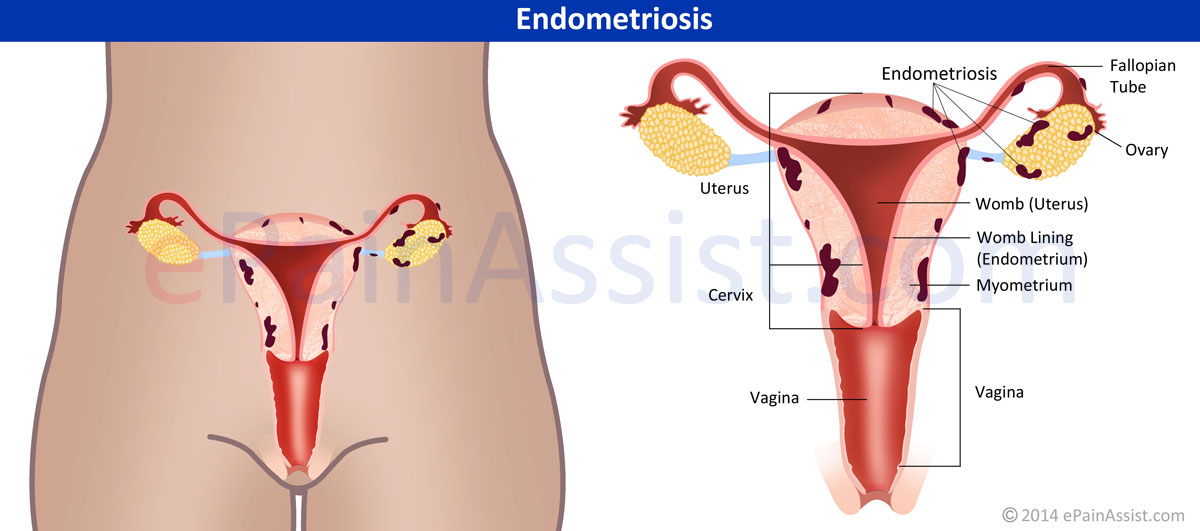It is a condition of female reproductive system where cells from lining of uterus start growing in other regions of body. This results in pain, erratic bleeding and problems with infertility. Endometriosis is one of the most common gynecological problems today and usually takes a long time before it gets diagnosed. Patients suffering from endometriosis may experience severe pain, which hinders their day to day activities. Endometriosis also causes infertility in some women. Another sign of endometriosis is extremely painful periods. There is no definite cure for endometriosis. Hormone therapy and laparoscopy helps in relieving the symptoms. Hysterectomy, i.e. removing the uterus, fallopian tubes, and both ovaries is a best chance for a cure. In rare cases, the disease can return.
Causes and Risk Factors of Endometriosis
Every single month, the ovaries present in the female body produce hormones which cause cells lining the uterus to become thicker. The body eliminates these surplus cells from lining of uterus, i.e. endometrium, when the woman gets her periods. When these endometrial cells start growing or get implanted outside uterus, it results in endometriosis. These growths are known as endometrial tissue implant. Females suffering from endometriosis often have these implants on ovaries, bladder, bowel, rectum and lining of pelvic region. These tissue implants can appear in other regions of body as well. When the patient has her period, these tissue implants present outside the uterus stay in place and do not get eliminated and may also bleed a little bit. With the next period they may grow again and this process goes on causing pain and other symptoms of endometriosis. The cause of this condition is unknown. One assumption is that after endometrial cells get shed during periods they travel backwards through the fallopian tubes into pelvis and implant and start growing there. This condition is known as retrograde menstruation.
Endometriosis is also hereditary. It is commonly diagnosed between the ages 25 to 35; however, this condition could start when the patient starts having her regular periods. Women with family history of endometriosis are at increased risk to develop this condition. Other risk factors for developing endometriosis are:
- Patient attaining menarche early.
- Have not given birth to children ever.
- Having periods very frequently or periods lasting for a week or more.
- If the patient has a closed hymen which obstructs blood flow during periods.
Signs and Symptoms of Endometriosis
- The main symptom of endometriosis is pain.
- Pain during periods.
- Patient suffers from pain in the lower abdomen at the time of or before her periods.
- There may be cramps around a week or two before the menstruation and during menstruation. The nature of the cramps may be steady with the severity ranging from dull to severe.
- Pain with or immediately after sexual activity.
- Pain occurring with bowel movement
- Low back pain or pain in pelvis during menstrual cycles.
- Sometimes, patient may not have any symptoms at all, even if their condition is severe; whereas, some patients having mild amount of this disease may experience severe pain.
Investigations for Endometriosis
- Physical examination
- Pelvic examination
- Transvaginal ultrasounds
- Laparoscopy of Pelvis
Treatment for Endometriosis
Treatment Is Based On The Following Aspects:
- Individual’s age.
- Symptom severity.
- Disease severity.
- Whether the patient wants to get pregnant in future.
In case of mild symptoms or if patient does not want to have children, then regular examinations every 6 to 12 months can be done to ensure that the disease is not progressing. The symptoms can be managed by:
- Exercising
- Using relaxation techniques
- Using NSAIDs like ibuprofen or naproxen.
- Prescription painkillers help alleviate cramping and pain.
Other Treatments Include:
- Pain medications, hormonal medications to stop progression of endometriosis.
- Surgery is done if there is unrelenting pain to remove areas of endometriosis or complete uterus and ovaries (hysterectomy). Pelvic laparoscopy is done for diagnosis of endometriosis and removing all endometrial tissue implants and adhesions.
- In case of severe symptoms or if patient does not wish to get pregnant, then hysterectomy is carried out to remove uterus. A single or both ovaries may also be removed as well as the fallopian tubes. If the ovaries are not removed, then the chances or symptoms returning are more.
Prognosis for Endometriosis
There is no definite cure for the endometriosis. Hormone therapy and laparoscopy helps in relieving the symptoms. Hysterectomy, i.e. removing uterus, fallopian tubes, and both ovaries is best chance for definitive treatment. In rare cases, this condition may also return.

